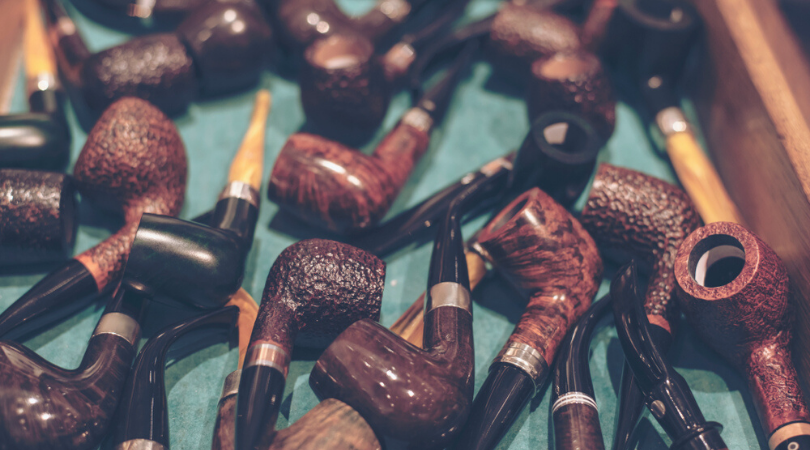
Getting a new hobby can be both exhilarating and challenging.
This couldn’t be more true about tobacco pipes.
Not knowing how to properly choose a tobacco pipe can have you end up frustrated and make you lose interest in smoking tobacco in other ways than a cigarette.
We’ve put together this guide to help you choose the right tobacco smoking type for your preferences based on their shapes, styles, and materials.
How to Choose Your First Tobacco Pipe
Buying a pipe is the first step for any new tobacco pipe smoker. Many people are confused with all the different shapes, styles, and materials, so the whole process may seem daunting at first.
Fear not, we’ve got everything covered for you.
Let’s get started!
Step 1: Choose the Material
There are three common materials used in the construction of tobacco pipes:
- Briar wood
- Corn cobs
- Meerschaum
Here’s an overview of each material:
Briar Wood
This is the most popular material used for making tobacco pipes. The vast majority of pipes you see in your local store or online are made from this type of wood. Briar is sourced from the roots of the Erica Arborea tree, a plant native to the Mediterranean regions. It’s a saltwater-tolerant material, which makes it extremely durable, breathable, and heat resistant. The pores of briar wood can only be seen on a microscopic level. This, in turn, allows to absorb the heat and oil released by tobacco when it’s burning.

Corn Cobs
Also known as “cob”, the corn cob is the most affordable material for making tobacco pipes. The pipe is built by drying out a cob of corn, drilling out the center, and placing a stem inside. Many smokers prefer cob pipes to other types because they’re relatively cheap, easy to maintain, and nostalgically rustic.
Meerschaum
Meerschaum can be found in Turkey near the Black Sea. Original meerschaum is much more expensive than briar wood or corn cob. That’s because this material is easily carved, meaning pipe makers can use it to create intricate shapes and styles of tobacco pipes. Despite the higher cost, Meerschaum pipes are widely desired by tobacco enthusiasts, especially those who appreciate a craft piece in their collection.
Step 2: Pick the Shape of Your Pipe
Once you’ve made yourself familiar with the basic materials for making tobacco pipes, it’s time you choose the shape of your tool.
Choosing the shape boils down to your preferences. Some smokers enjoy long stemmed pipes, whereas others want the stem to be very short. Some only like fat pipes, others prefer skinny.
If any shape “speaks” to you at the moment, feel free to pick it. There is no one correct shape. Whatever you choose must suit you and make the smoking experience enjoyable.
There are four things to consider when choosing from different tobacco smoking pipes:
- Chamber Shape and Size
- Stem Shape
- Finish
- Design
Chamber
The chamber is where you load the tobacco. Knowing the right size of the chamber helps you manage your smoking experience in many ways.
Larger chambers are better for longer sessions because they can load more tobacco. They also come with a deeper depth.
If you want an occasional short smoke, you want to invest in a pipe that has a smaller chamber
The shape of the chamber is important too.
Most pipes come with perfectly cylindrical chambers. However, some pipes have a conical chamber that gets thinner down the bowl. This usually makes your tobacco burn faster and produces a more intense flavor at the end of the smoke.
Stem Shape
You have two choices when it comes to the shape of your pipe’s stem. Which shape you choose depends on both preferred aesthetics and expected performance.
Both shapes have their pros and cons, which is why many smokers decide to have both in their collections. Again, there’s no “one and only” place to start — the choice is up to you.

Finish
As mentioned, tobacco smoking pipes come in a myriad of shapes, styles, materials, and finishes. Choosing from all those options can be a little overwhelming. The good news is that not all features affect the pipes performance.
Frankly the finish of a pipe has no real influence on how it works. Some people claim the finish cools the smoke, but we’re not sure if that’s the case. The choice between rustic, smooth, sandblasted, or other type of finish will not affect your tobacco smoking experience at all.
Design
Different types of tobacco pipes have different purposes, so ask yourself the following questions:
- Are you going to smoke out of this pipe on a daily basis?
- Will you use it for indoor or outdoor smoking?
- Is the piece more practical or rather reserved for special occasions?
The reason we’re bringing this up is that you may not want to pull out an artisan pipe worth a few hundred dollars during your friend’s barbecue. If this is your first time with smoking a tobacco pipe, a decent piece will cost you around $25-50.
As you continue to fall for your new hobby, you may start to add more expensive pieces to your collection.
Final Thoughts on Different Tobacco Smoking Pipe Types
There’s a plethora of options to choose from when it comes to tobacco smoking pipes. These handy devices come in different shapes, styles, and materials, so the choice may be a bit overwhelming for a beginner.
Thankfully, most features are about personal preferences, so it usually boils down to whether you prefer a lighter or more intense flavor of your tobacco, or how you like to hold your pipe. If you’re a pipe connoisseur, exploring the world of tobacco smoking pipes is extremely fun and can land you a few unique pieces you won’t be able to stop staring at.
What are your favorite types of tobacco smoking pipes? Let us know in the comments below!





